'My grandfather's hidden wartime photo album'
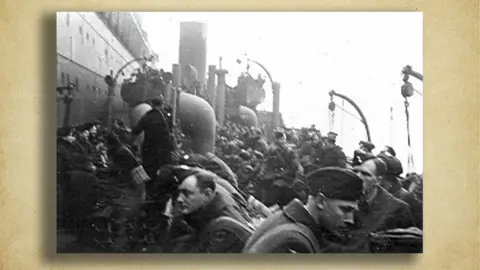 BBC
BBCPeter Goffin's grandfather told many stories of his war years in the UK with the Canadian Air Force, but only ever showed his family one photograph - of his wedding to a Welsh bride, Peter's grandmother. But after he died, an album was discovered that provided images to accompany the tales the family knew so well.
The photo album had been right under my nose, my whole life. It was tucked into a drawer in my grandfather's house, under a bookcase I'd perused a hundred times, as I rummaged through the treasures and assorted oddities of that home I loved so much.
I spent my childhood surrounded by an extended, tight-knit family in Toronto, Canada. Get-togethers were big, glorious, noisy affairs with everyone, young and old, sitting around the same table.
My paternal grandfather, already retired, often came round to babysit. He would take my sister and me on day trips and stay home with us when we were sick.
I was named Peter after him, and I idolised him. He was a yarn-spinner and an expert joke-teller. He loved history, and had an encyclopaedic knowledge of the past, which he loved to share.
My favourite stories were about his experiences in World War II, and there was plenty to hear about.
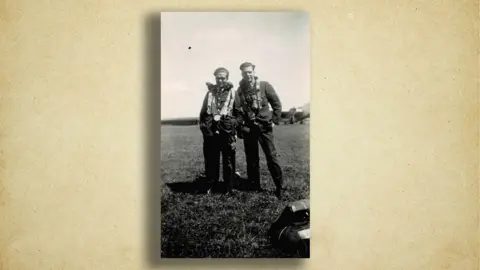
My grandfather enlisted in the Royal Canadian Air Force in 1940 and he was put to work on the Allies' top-secret, new weapon: radar.
Early in the war, Britain asked the Canadian government to recruit and train bright young men for what was then called Range and Direction Finding. Some 6,000 Canadian radar mechanics were placed with Royal Air Force units and sent to every corner of the globe.
He was dispatched to RAF St Athan, an air base in south Wales, where he installed and maintained radar equipment in planes like Mosquitoes, Halifaxes and Beaufighters.
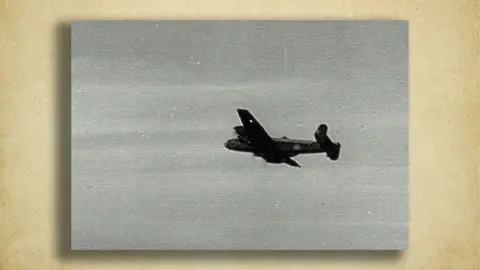
I loved these tales of going up in these famous fighters and bombers on test runs, of the camaraderie on base, even the drudgeries of guard duty or rushing to breakfast in the mess. I found it all fascinating.

The war also played a pivotal role in my family's history. It was while stationed in Wales that my grandfather met my grandmother.
They married in October 1944 in her home town of Radyr, a few miles outside Cardiff. Months later, when they learned she was pregnant, my grandmother was sent to Canada to live with in-laws she'd never met, until my grandfather came home from the war. Her ship, full of war brides, zig-zagged across the Atlantic to evade U-boats.
My grandfather was proud of his war work, and never seemed to shy away from talking about it. I knew his stories backwards and forwards, but I only ever saw one image from this period in my grandparents' lives. It was their wedding photo, and it sat in a cabinet in my parents' front hall, surrounded by other age-old family snaps - each generation afforded one photo of their younger years.
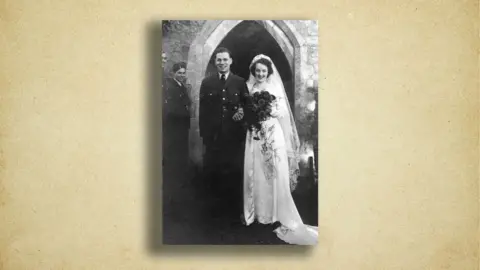
That changed after my grandfather died in 2000.
While my family sorted through his belongings we found a black, leather-bound album, in a drawer in the basement. It was filled with more than 300 photos taken between 1940 and 1945, most of which we'd never seen before.
My grandfather is in some of the photos; in others he's clearly the one behind the camera. On the backs of each he wrote a caption, which may indicate that he was sending them home to his parents.
The pictures do not reveal much about his radar work. Radar mechanics were sworn to secrecy with a government oath that didn't officially expire until the 1990s.
But they do provide a glimpse of life in the RAF - and in Britain in general - during World War Two.

There are shots of the troop ship packed with servicemen bound for England and points beyond (see top of page). There is something haunting about the faces of these anonymous men that provokes questions. Where did they end up? Did they survive the war? Do their families know their stories?
Once the setting shifts to Britain, I start to recognise elements of my grandfather's stories, illustrated in black and white.
There are the guard huts and the barracks buildings I'd heard described so many times. There are photos taken during test flights, out the nose of a Halifax bomber or the cockpit of a Beaufighter as it rises above the clouds.


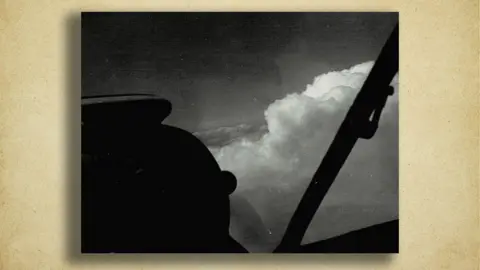
And of course, there is my grandparents' budding relationship, which my grandfather documented from its earliest days. There's a photo of grandmother which my grandfather was sending home to his parents, as a way of introducing them to the girl he wanted to marry. "The Rose of Glamorgan" he calls her in a note on the back of the print.
The album documents a great coming-of-age journey. When my grandfather left home he was a teenager, not that long out of high school. In one of the earliest photos, he poses in front of his parents' house in his new air force uniform, trying to affect the look of a serious soldier. He's 19, but looks even younger, and his jacket hangs off his thin frame like he's dressing up in someone else's clothes.
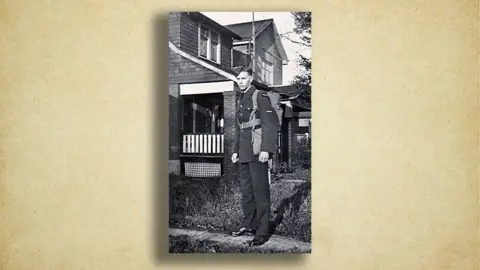
In snap after snap, you see him growing up to become a dashing airman, dating girls and going up to London with his mates.
His sense of humour - quick, and creative and sometimes corny - is on full display in the captions scrawled on the backs of each photo.
He and his friends are described with an ever-changing array of nicknames like Pruneface and Gabby and Tubby and Two-Gun. Pictures of them in full combat equipment are labelled "The Commando Quartet," and "In fightin' mood or something".
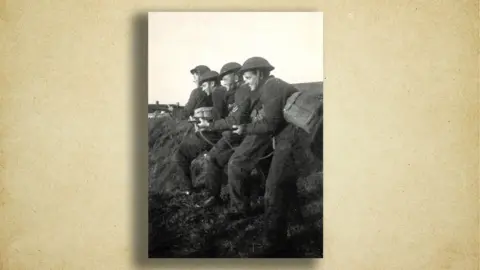
In these photos, I see elements of modern-day posts on Instagram or Facebook. Eighty years ago, at the height of the war, 21-year-olds were already taking goofy snaps of their friends while at the pub, or out for a bike ride, and trying to come up with a clever photo caption.
The photos also show that he and a large group of friends from his unit went up to London several times on leave, young men on lads' trips to the capital.
And yet there are, especially in these London photos, jarring reminders that Britain was a war zone.
In my mind, my grandfather's war stories tended towards the light-hearted. Maybe they were edited for my young ears.
Now, as I sit in my London flat and look through these old photos of the city I know so well, I am struck by the unrelenting signs of danger and death at every turn.
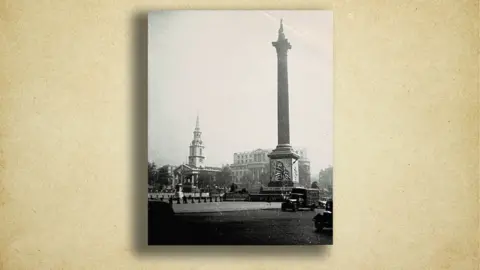

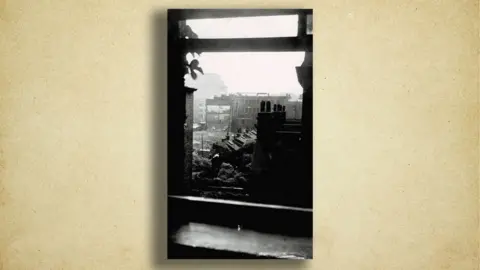
Trafalgar Square is almost empty. The base of Nelson's Column is wrapped in advertisements for war bonds. The King's Guards at Buckingham Palace wear khaki fatigues and tin helmets, rather than red coats and bearskin hats.
Blocks of flats have been wrenched open by bombs, the rubble spilling out into courtyards. Children play in a giant crater in Hyde Park. At night, from his hotel room near Paddington Station, my grandfather took photos of German incendiary bombs lighting up the sky, a row of chimneys silhouetted by a ball of flame.
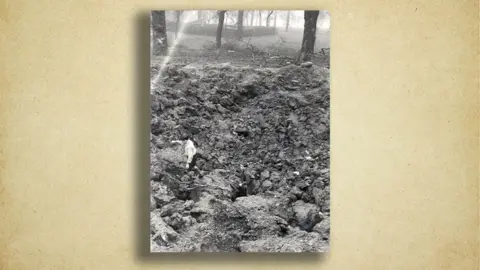

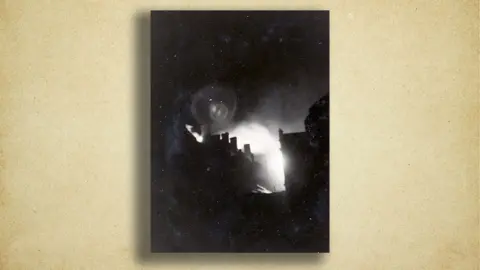
I wonder sometimes why he never showed us his wartime photos. But the album offers a clue - life moved on.
The final images in the book show my grandfather back in Toronto with his wife and infant son, my uncle, born just a few weeks after Victory in Japan.
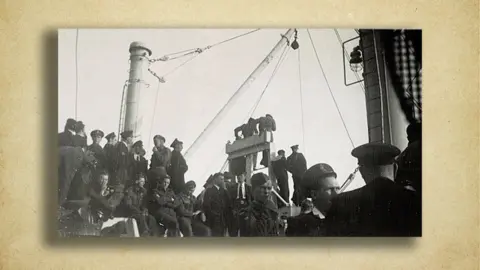
In the months ahead, my grandparents would buy one of the ubiquitous bungalows built all over North America for returning servicemen. My great-grandparents moved in next door, in a foreshadowing of the tight family unit I grew up in.
My grandfather went to night school and began a long and distinguished career in Canada's civil service, while my grandmother worked at a department store. Together they raised three boys, moved to the suburbs and lived the embodiment of the post-war dream.
It was a full and bountiful life, and the war made up just one chapter of it.
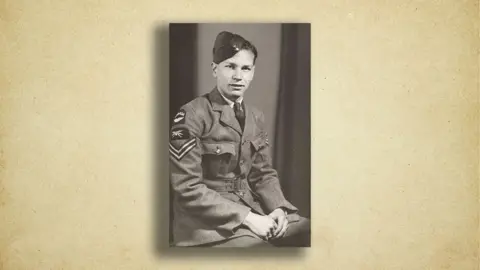
In that respect, my grandfather is not unique. Hundreds of thousands of men and women went away to war, taking part in one of the most significant events in world history. And then, when it was over, and the lucky ones had come home, they went ahead and lived the rest of their lives.
My grandfather never stopped taking photos, but they were of people and things that arguably mattered more: my dad's childhood, family parties, summers at the cottage, trips abroad, days my sister and I spent with Grandad.
These were the photos I did see, while the war pictures were kept in the basement. I have no doubt that my grandfather was proud of his war service. But most of all, I think, he was proud of his family.
You may also be interested in:
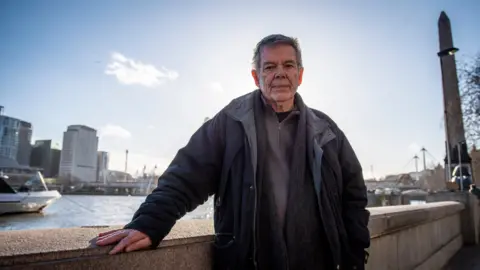 Phil Coomes
Phil CoomesTony May was only a few weeks old when he was abandoned by the River Thames in London, in the middle of World War Two. He had no idea who his parents were for more than 70 years. Then a DNA detective dug up the truth about his past.
